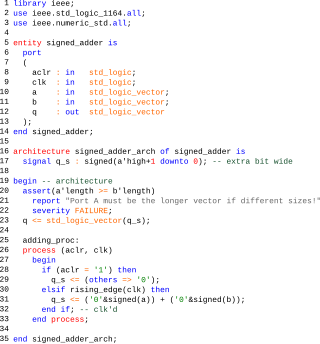
Configuration management (CM) is a process for establishing and maintaining consistency of a product's performance, functional, and physical attributes with its requirements, design, and operational information throughout its life. The CM process is widely used by military engineering organizations to manage changes throughout the system lifecycle of complex systems, such as weapon systems, military vehicles, and information systems. Outside the military, the CM process is also used with IT service management as defined by ITIL, and with other domain models in the civil engineering and other industrial engineering segments such as roads, bridges, canals, dams, and buildings.

MIL-STD-188 is a series of U.S. military standards relating to telecommunications.

The VHSIC Hardware Description Language (VHDL) is a hardware description language (HDL) that can model the behavior and structure of digital systems at multiple levels of abstraction, ranging from the system level down to that of logic gates, for design entry, documentation, and verification purposes. Since 1987, VHDL has been standardized by the Institute of Electrical and Electronics Engineers (IEEE) as IEEE Std 1076; the latest version of which is IEEE Std 1076-2019. To model analog and mixed-signal systems, an IEEE-standardized HDL based on VHDL called VHDL-AMS has been developed.
MIL-STD-1750A or 1750A is the formal definition of a 16-bit computer instruction set architecture (ISA), including both required and optional components, as described by the military standard document MIL-STD-1750A (1980). Since August 1996, it has been inactive for new designs.
A vehicle bus is a specialized internal communications network that interconnects components inside a vehicle. In electronics, a bus is simply a device that connects multiple electrical or electronic devices together. Special requirements for vehicle control such as assurance of message delivery, of non-conflicting messages, of minimum time of delivery, of low cost, and of EMF noise resilience, as well as redundant routing and other characteristics mandate the use of less common networking protocols. Protocols include Controller Area Network (CAN), Local Interconnect Network (LIN) and others. Conventional computer networking technologies are rarely used, except in aircraft, where implementations of the ARINC 664 such as the Avionics Full-Duplex Switched Ethernet are used. Aircraft that use AFDX include the B787, the A400M and the A380. Trains commonly use Ethernet Consist Network (ECN). All cars sold in the United States since 1996 are required to have an On-Board Diagnostics connector, for access to the car's electronic controllers.
Mixed-excitation linear prediction (MELP) is a United States Department of Defense speech coding standard used mainly in military applications and satellite communications, secure voice, and secure radio devices. Its standardization and later development was led and supported by the NSA and NATO.
MIL-STD-1553 is a military standard published by the United States Department of Defense that defines the mechanical, electrical, and functional characteristics of a serial data bus. It was originally designed as an avionic data bus for use with military avionics, but has also become commonly used in spacecraft on-board data handling (OBDH) subsystems, both military and civil, including use on the James Webb space telescope. It features multiple redundant balanced line physical layers, a (differential) network interface, time-division multiplexing, half-duplex command/response protocol, and can handle up to 31 Remote Terminals (devices); 32 is typically designated for broadcast messages. A version of MIL-STD-1553 using optical cabling in place of electrical is known as MIL-STD-1773.
MIL-STD-498, Military Standard Software Development and Documentation, was a United States military standard whose purpose was to "establish uniform requirements for software development and documentation." It was released Nov. 8, 1994, and replaced DOD-STD-2167A, DOD-STD-2168, DOD-STD-7935A, and DOD-STD-1703. It was meant as an interim standard, to be in effect for about two years until a commercial standard was developed.
A United States defense standard, often called a military standard, "MIL-STD", "MIL-SPEC", or (informally) "MilSpecs", is used to help achieve standardization objectives by the U.S. Department of Defense.
A hazard analysis is used as the first step in a process used to assess risk. The result of a hazard analysis is the identification of different types of hazards. A hazard is a potential condition and exists or not. It may, in single existence or in combination with other hazards and conditions, become an actual Functional Failure or Accident (Mishap). The way this exactly happens in one particular sequence is called a scenario. This scenario has a probability of occurrence. Often a system has many potential failure scenarios. It also is assigned a classification, based on the worst case severity of the end condition. Risk is the combination of probability and severity. Preliminary risk levels can be provided in the hazard analysis. The validation, more precise prediction (verification) and acceptance of risk is determined in the risk assessment (analysis). The main goal of both is to provide the best selection of means of controlling or eliminating the risk. The term is used in several engineering specialties, including avionics, chemical process safety, safety engineering, reliability engineering and food safety.
The IEEE Std 1901-2010 is a standard for high speed communication devices via electric power lines, often called broadband over power lines (BPL). The standard uses transmission frequencies below 100 MHz. This standard is usable by all classes of BPL devices, including BPL devices used for the connection to Internet access services as well as BPL devices used within buildings for local area networks, smart energy applications, transportation platforms (vehicle), and other data distribution applications.
Reliability-centered maintenance (RCM) is a concept of maintenance planning to ensure that systems continue to do what their user require in their present operating context. Successful implementation of RCM will lead to increase in cost effectiveness, reliability, machine uptime, and a greater understanding of the level of risk that the organization is managing.
DOD-STD-2167A, titled "Defense Systems Software Development", was a United States defense standard, published on February 29, 1988, which updated the less well known DOD-STD-2167 published 4 June 1985. This document established "uniform requirements for the software development that are applicable throughout the system life cycle." This revision was written to allow the contractor more flexibility and was a significant reorganization and reduction of the previous revision; e.g.., where the previous revision prescribed pages of design and coding standards, this revision only gave one page of general requirements for the contractor's coding standards; while DOD-STD-2167 listed 11 quality factors to be addressed for each software component in the SRS, DOD-STD-2167A only tasked the contractor to address relevant quality factors in the SRS. Like DOD-STD-2167, it was designed to be used with DOD-STD-2168, "Defense System Software Quality Program".
Logistics Support Analysis (LSA) is a structured approach to increase efficiency of maintenance and reduces the cost of providing support by preplanning all aspects of Integrated Logistics Support. A successful LSA will define those support requirements that are ideal for the system design.

Electrical or fiber-optic connectors used by U.S. Department of Defense were originally developed in the 1930s for severe aeronautical and tactical service applications, and the Type "AN" (Army-Navy) series set the standard for modern military circular connectors. These connectors, and their evolutionary derivatives, are often called Military Standard, "MIL-STD", or (informally) "MIL-SPEC" or sometimes "MS" connectors. They are now used in aerospace, industrial, marine, and even automotive commercial applications.
The terms "DOD-STD-2167" and "DOD-STD-2168" are the official specification numbers for superseded U.S. DoD military standards describing documents and procedures required for developing military computer systems. Specifically:

IEEE 1394 is an interface standard for a serial bus for high-speed communications and isochronous real-time data transfer. It was developed in the late 1980s and early 1990s by Apple in cooperation with a number of companies, primarily Sony and Panasonic. Apple called the interface FireWire. It is also known by the brand names i.LINK (Sony), and Lynx.
ISO 10007 "Quality management — Guidelines for configuration management" is the ISO standard that gives guidance on the use of configuration management within an organization. "It is applicable to the support of products from concept to disposal." The standard was originally published in 1995, and was updated in 2003 and 2017. Its guidance is specifically recommended for meeting "the product identification and traceability requirements" introduced in ISO 9001:2015 and AS9100 Rev D.
MIL-STD-461 is a United States Military Standard that describes how to test equipment for electromagnetic compatibility.
ANSI/EIA-649, "National Consensus Standard for Configuration Management", is an industry standard for configuration management.




